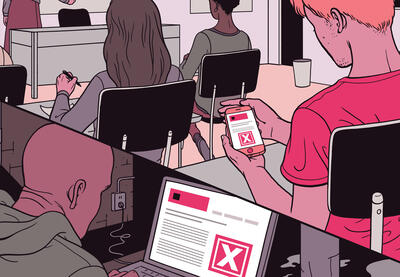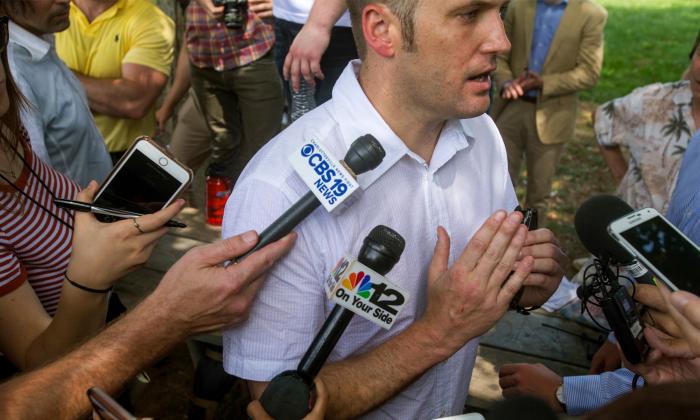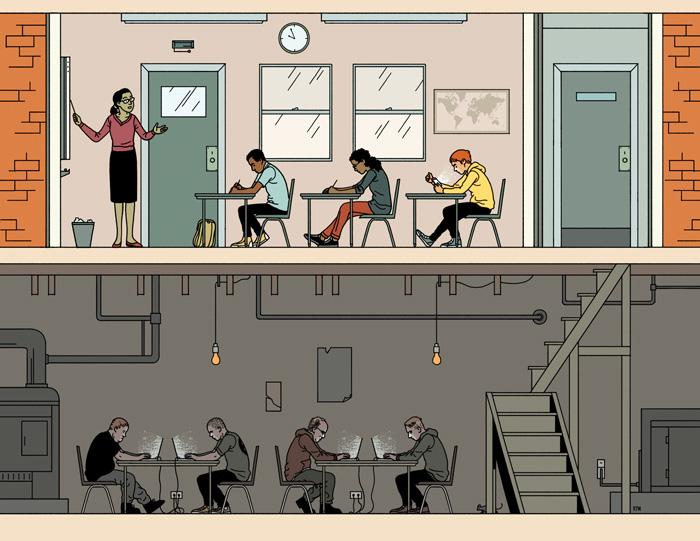“It has swallowed up most of the guys in the senior class at my school. ... Every discussion devolves into things like which girls are ‘feminazis,’ celebrities dating outside their ethnicity being ‘white genocide,’ and so on. … I’m genuinely scared that it’s going to spread to the point where I won’t have anyone I can talk to like a normal human being.”
These words were written by a teenager to The American Conservative magazine. The “it” he says has overtaken his classmates: the so-called "alt-right," a loosely affiliated group whose teen-friendly messaging inspired the spread of fascist ideals among his friends. The group espouses beliefs so far outside the mainstream that their popularity is causing widespread anxiety and alarm, even to people who, like the young man who wrote the email, embrace their right-wing identities.
For educators, a more imminent concern comes with the alt-right’s rise: They’re recruiting.
Decoding the Alt-Right
For the misunderstood, the misanthrope or for a person who simply feels amiss, an “alternative” represents one of three things: a new path, a new plan of action or a new reality.
For Richard Spencer—who is quickly becoming the most visible white nationalist in the United States—“alternative” represented a chance to rebrand.
Spencer is often credited for coining the term “alternative right” in 2008. Its meaning is vague, used as an umbrella term encompassing right-wing ideals at odds with establishment conservatism and multicultural society.
Keegan Hankes is an intelligence analyst at the Southern Poverty Law Center who studies the alt-right. “The animating grievance of the alt-right is the same thing as white nationalism,” Hankes says. “Concern over white identity, belief that Western civilization is crumbling, that liberal democracy has failed, and that a symptom of this failure is multiculturalism.”
Today, an online community comprised of entertainment-seeking trolls and true white nationalists find themselves mingling within this amorphous movement. This makes it difficult to land on a singular comprehensive definition of the alt-right. The term refers to an ideological island that hosts (all at once) a joke shop, a meme factory, media influencers, a Neverland for lost boys who feel disempowered or a dangerous sociopolitical movement—depending on who you ask.
Both contradiction and connection define the different factions of the alt-right. On one side is what Data & Society calls an “aggressive trolling culture,” individuals who use inside jokes and hate speech to inspire anger. On the other side are new media personalities and social media influencers who are spreading racist, anti-multiculturalist, anti-feminist propaganda. These sides unite behind a nostalgia for a past in which diversity wasn’t openly embraced, and behind a disdain for what they perceive to be obstacles that keep them from “traditional” white masculine entitlements: racial and sexual dominance and economic power.
It wasn’t always this way. Dale Beran, a comic-book writer who has taught at both the middle school and college levels, has closely followed online forums like 4chan and others that gave birth to many alt-right leaders, tactics and messaging. Beran says he has seen a fundamental shift in the ideas expressed in those forums over time.
“They kind of started out as trolls, and people who were making fun of the fact that they didn’t get out of their mom’s basement or their life was not working out, or that they kind of identified as losers,” Beran explains. “That slowly kind of transformed into a political platform of taking your powerlessness and feeling empowered by it using far-right ideology. Over time, the irony kind of melts away.”
What remains is messaging that teachers would be remiss to interpret as harmless jokes or outlier opinions. When these rhetorical exchanges make their way out of online communities and into classrooms, they threaten safe learning environments in schools, particularly for students who belong to identity groups viewed as problematic or inferior by members of the alt-right.
Of equal concern is the fact that students susceptible to alt-right messaging can easily fall down a wormhole of online radicalization.
“I think you need to get them while they are young,” Spencer has said.
That is exactly what the alt-right is banking on.
Richard Spencer: Coined the term “alt-right” and founded AlternativeRight.com. The white nationalist is the alt-right’s most visible figure and is the head of the National Policy Institute.
4chan: An imageboard founded by 15-year-old Christopher Poole in 2003. The board, which features mostly anonymous users and little content regulation, gave birth to many of the internet’s most-used memes. Its politics board, /pol/, served as an origin point for many alt-right trolls and tactics.
How the Alt-Right Appeals to Young People
“The thing that the alt-right does better than white nationalism has done, in the years that I’ve been tracking it, is it gets young people involved,” Hankes says.
With its origins in online culture, the alt-right speaks the language of millennials and younger generations. Information (and disinformation) is distilled into easy-to-digest videos, memes and sound bites, often imbued with a snarky, “nobody-understands-me” tone.
It is, by design, an affiliation that appeals to young people. Speaking at a conference in Washington, D.C., Spencer once said of the alt-right: “It’s edgy and dangerous, it’s cool and hip. It’s that thing our parents don’t want us to do.”
Spencer and others have made it a priority to target young, impressionable minds. He, Milo Yiannopoulos and other figures tied to the alt-right speak on college campuses. The Pettibone sisters have started a young-adult book series. Daily Stormer founder Andrew Anglin made headlines with a publicity stunt in which he claimed to recruit kids through Pokémon Go.
But such outreach is barely necessary. Alt-right outlets reach young people through their phones. Unlike the far-right leaders of yesteryear, today's alt-right leaders are tech-savvy and skew young, giving them an air of relatability that few politicians or activists can match.
“Social media can be very powerful in shaping outlooks, but it doesn’t operate in a vacuum,” explains Data & Society researcher Becca Lewis. “The shaping is coming from the other people using the platforms.”
The alt-right has a massive presence on social media and other channels where young people congregate. A Washington Post analysis identified 27,000 influential Twitter accounts associated with the alt-right, 13 percent of which are considered radical. Later, a George Washington University study found that white nationalist accounts in the United States have seen their follower counts grow by 600 percent since 2012.
According to a Data & Society report, young people tend to find their news via social media, prefer user-generated content (e.g., videos) and distrust traditional outlets. At the same time, young people seek emotional connections to sources and, thanks to confirmation bias and online algorithms, fall into echo chambers where their views are rarely challenged.
“That’s kind of the problem with … the intensive tailoring of [online] information,” explains Dr. James Hawdon, director for the Center for Peace Studies and Violence Prevention at Virginia Tech. “You just get led into this rabbit hole of increasingly extreme ideas.”
For young people, the race to construct their online echo chambers may also be the race to construct their belief systems.
“If you catch an impressionable young person at the right time, that could easily be your red pill, as [the alt-right] would call it,” Hankes said.
And their messages are already echoing in high school hallways.
The young man who wrote to The American Conservative in February expressed his concern over alt-right ideas spreading rapidly among his once-conservative, Christian-school peers, whom he called angry and aimless.
“It’s absolutely nuts, but what am I going to do?” he wrote. “[M]aybe that’s just the norm for kids my age now, and I’m going to just have to be paranoid that everyone that I meet is secretly a white nationalist.”
Hawdon is in the midst of a study of online radicalization in the United States. The alt-right represents the most “far-reaching” group, he says, and the message resonates primarily with young men.
“A consistent message in the alt-right movement is that working-class white males are being shut out and the government is looking out for all these other groups and the world is being taken away from us,” Hawdon says. “Especially if you spent a lot of time online, you could become convinced that everyone in the world is being handed [opportunities] except for you.”
How often do these ideas reach young people? Hawdon’s research found that nearly two-thirds of respondents ages 15 to 35 had seen extremist messages within the past three months.
What draws them in? According to Lewis, teenage angst and the alt-right’s “specific tactics online for radicalizing young men” create an appealing combination.
“Teenagers often go through phases of rebellion as they shape their identities,” says Lewis. “4chan and 8chan can be really appealing places to experiment with shocking and subversive ideas.”
Those ideas, when diluted (or cloaked in humor) draw in a broad audience and open a door for young people who may not engage with extreme ideas otherwise.
Milo Yiannopoulos: Former Breitbart writer who made a name for himself by reporting on factions of the alt-right. His primer on the movement helped push the alt-right into mainstream discourse.
The Daily Stormer: Neo-Nazi website named after Nazi propaganda sheet Der Stürmer, featuring a “Stormer Troll Army” community behind several harassment campaigns. The site mixes memes and anti-Semitic and racist rhetoric into a news-website format.
Andrew Anglin: Founder of The Daily Stormer and former 4chan troll who has spearheaded several campaigns of disinformation and harassment.
redpilled: First appropriated from The Matrix, then from the “manosphere” of 4chan culture, redpilled refers to protagonist Neo’s choice to take the red pill (as opposed to the blue pill) in order to see the truth about society. For the alt-right, it means espousing their viewpoints and seeing through the lies purportedly spread by feminists, mainstream media and multiculturalists.
8chan: Like 4chan, but even less regulated, the /pol/ board is an epicenter of far-right organizing, be it serious or “for the lulz,” and features many of the alt-right’s most distasteful memes and messages.
Which Students Are Susceptible?
While Hawdon cautions that “basically, anyone can be radicalized,” a typical profile does emerge for students susceptible to alt-right messaging: young, white, male and—in some way—feeling powerless.
Dale Beran saw a pattern of young men who felt humiliated by traditional standards, whether because they were underemployed or deemed undesirable by women. Alice Marwick and Becca Lewis of Data & Society also noted a common disdain for “political correctness” and, often, social isolation in schools or communities.
By its very nature, online radicalization happens outside of the classroom. But Hawdon says that teachers have a unique opportunity to stop radicalization in its tracks.
Maybe that’s just the norm for kids my age now, and I’m going to just have to be paranoid that everyone that I meet is secretly a white nationalist.
“The thing about radicalization is it tends to be progressive,” he says. “[Those being radicalized] go through several phases.”
Teachers who see students' creative or personal writing have the ability to recognize the rhetoric, Hawdon says. If far-right rhetoric (e.g., anti-Semitic sentiments, xenophobia, racist pseudo-science, etc.) finds its way into a story, make a note of it, he says.
Alt-right rhetoric often cloaks its meaning behind pop-culture references and inside jokes. But if teachers learn to recognize these red flags, they can recognize students who are at risk—and step in.
“If it starts happening again and these stories become increasingly extreme and increasingly violent, that’s a kid who’s on the path,” Hawdon says. “If people can intervene early enough, then they can be diverted from that path.”
Combating the Alt-Right in Class
Diversion can begin in the classroom, perhaps before students are even exposed to alt-right messaging. The first key, according to experts: Do not normalize the alt-right.
“If I was a teacher, I would really just hit home that, again, where there’s smoke, there’s fire,” Hankes says. “If the leaders are stated white nationalists, it feels like white nationalism, they’re arguing for an ethno-state, then it is white nationalism.”
Many teachers worry about accusation of partisanship. But experts are clear that being affiliated with the alt-right is in no way the equivalent of being right-of-center, nor is there any need to obscure or soften the alt-right’s messages with euphemisms.
Instead, teachers can undercut propaganda by teaching about the struggles faced by the marginalized groups the alt-right often targets.
“I would just do everything in my power to humanize the would-be victims,” Hankes says. “It needs to be clear there’s only one road to an ethno-state, and that’s by some sort of, most likely, violent program to reverse diversity.”
The Atlantic recently profiled teachers Kathryn Leslie and Malcolm Cawthorne, who used Richard Spencer’s own words as a vehicle to discuss extremist thoughts and how they might manifest. The open dialogue allowed students to discuss why someone might be swept up in alt-right messaging.
Beyond political and historical literacy, however, lies a skill set that could offer students the tools to avoid online radicalization on their own: digital literacy. Fostering digital literacy could, for example, help students understand how the alt-right takes advantage of a 24-hour thirst for headlines and garners mainstream media coverage for memes, conspiracy theories and misinformation campaigns. It could also inform students of how online and media climates can be so influential in shaping consumers’ worldviews.
“It’s obviously incumbent upon the education system to teach kids how to use computers and the web,” Hawdon says. “Educators need to be aware of this and need to warn their students about it and to encourage the use of the virtual world, the navigation of the virtual world, in such a way that students are at least aware of what’s happening.”
Students left to differentiate between the rational and the radical on their own remain vulnerable to the tactics of the alt-right, as do students who could experience harassment or worse as a result of the movement's success. On both edges of the political spectrum, online radicalization has led to acts of violence. The war against “political correctness,” fed in part by the alt-right, has led to unsafe and uncivil climates in schools and communities. And, as the August 12, 2017, "Unite the Right" rally in Charlottesville, Virginia, brought into stark relief, white-nationalist actors are presenting more public and more emboldened threats than they have in decades.
In that letter to The American Conservative, the student lamented, “I don’t know that any adults would take me seriously if I told them this was a problem.”
But what if they did?
Collins is a staff writer for Teaching Tolerance. Senior Editor Monita K. Bell contributed research to this story.








1 COMMENTS